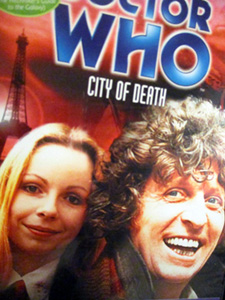The City of Death
“The centuries that divide me shall be undone.” – Scaroth
This is one of those stories that just works so well on many levels. A great cold open that takes a whole episode for us to connect to the rest. Location filming in Paris. A smart and witty script. Interesting direction like a view through the postcard stand and around the porticoes. The Doctor and Romana running hand-in-hand around the city debating things like if the best art gallery in the universe is the Louvre or the Academia Stellaris on Sirius Five. A suave villain with much underlying menace. Mysterious cracks in time that only the Time Lords can sense and a portentous sign that we’ll never know was coincidence or premonition. All this in just the first episode!
From there, the mystery of the story deepens with interesting concepts and reveal after reveal. Scarlioni is the alien we saw supposedly killed at the start. How did he become a count in modern day France? What’s in the secret cupboards—multiple Mona Lisas? No, multiple original Mona Lisas! How is the same count also in Renaissance France? We soon learn in short order that the original Scaroth was fractured in time into multiple copies of the same individual, linked overtime and pushing mankind’s technological evolution as far as it can go, and working on time technology to go back and stop it all. Not only would this paradoxically undermine established history—the last moments also reveal that it was his exploding spaceship that started life on earth itself! Heady stuff and a great layered story.
All this works even better because the script is full of wonderful tongue-in-cheek banter and ironic scenes. Tom and Lalla are at the top of their game having the Doctor and Romana being cheeky and brilliant. It’s the also height of the Doctor’s non-stop breezy patter in the face of danger and the bemused Scarlioni counters it perfectly. (The drawing room scene is full of appropriately famous quotes.) We get other interesting characters like Countess on her sad arc learning that riches have blinded her to the fact that she was living with a literal monster for years and bulldoggish Duggan whose silly punching and actually saves the day multiple times.
There are lots of small touches that are cool. The Doctor leaving notes for his friend Leo. The Count and company “practicing” their heist in a virtual reality copy of the Louvre—pretty standard fare nowadays but rather innovative for this time and well done on the budget of the show. Somehow the show managed to get John Cleese and Eleanor Bron to make a cameo(!). The script even fooled me on the rewatch–when the Doctor seems to randomly stumble into the main villain I assumed it was a contrived coincidence to move the story along, until its shown that he had noted a piece of alien technology on her person and did all that to snatch it from her in his silly flailing.
There are a few excesses in the story—like the cartoonish henchmen waving guns everywhere (surely people in a café wouldn’t be that blasé about that?) and Professor Karensky who is a little too much of a caricature. But these are just a few small squabbles with is what is a wonderful story considered to be one of the gems of the Baker era.
Best (or worst) unsettling moment:
There are many moments of us wondering what in the world is going on before it’s explained. I think them finding a stash of Mona Lisas buried centuries behind a wall is one of my favorites.
Retrofit:
I wondered as a kid what the people at the Louvre would have to do about the felt tip pen writing the Doctor left. I’ve decided that upon discovering it in X-ray they had to keep it secret but internally experts debated it for years. Finding that the artwork really was truly the “original”, their assumption would eventually be that the thieves found some hitherto unknown technique to inject the felt tip ink under the surface to write out those words as a prank.
Regrets:
Just the small bits noted above and a wish that the scenes of the time distortion could have been smoother (though I am sure they were good for the time).

